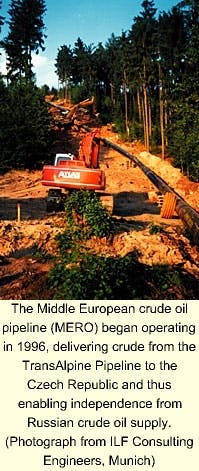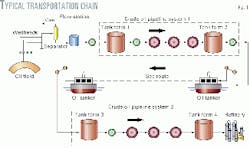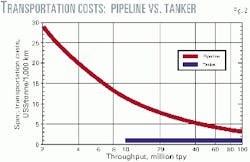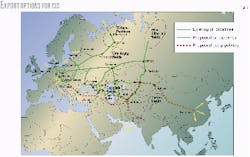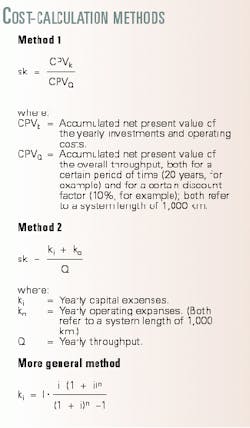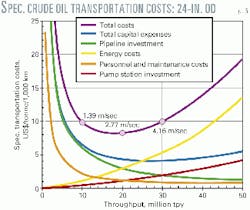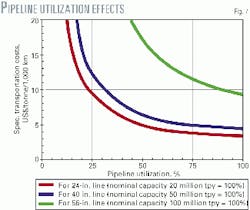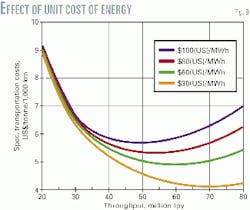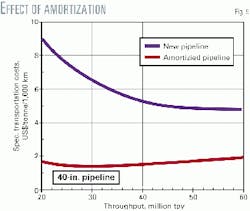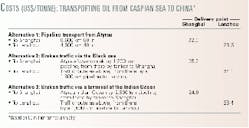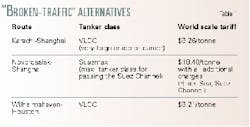Transportation costs for moving crude oil through long-distance (1,000 km and more) pipelines vary under such influences as throughput, pipe diameter, energy-unit rate, utilization factor, and amortization.
A method for weighting these elements is explained here and results are applied to transportation alternatives for crude oil pipeline options from the Caspian region to China and to the West, respectively.
It is shown that long-distance pipelines in fact can compete with ocean tanker transport if such preconditions as large throughput, high degree of utilization, cost-effective design and construction, low unit cost of energy, high hydraulic efficiency, and high degree of automation are met.
The results are especially important considering increased security demands for tanker traffic, especially within the European Union.
Erika ripple
Developing large crude oil reserves in remote, land-locked locations and targeting their production for markets far from the production field make consideration of long-distance pipelines a necessity.
In such a case, it is normal to find the shortest pipeline route to a marine terminal from where the oil can be shipped by large tankers to the market. Fig. 1 shows such a typical transportation chain consisting of two pipeline systems connected by tanker shipment.
The main reason for this approach is that the specific transportation costs by tanker are much lower than those by pipeline (Fig. 2).
In general, therefore, pipeline transport over long distances is economically attractive only absent a tanker alternative for a distance of comparable length.
The value for the specific tanker transportation cost, however, fails to address recent developments in the European Union that most probably will lead to a significant increase of this value: The European Union plans to ban single-hulled oil tankers from EU ports as a consequence of the accident of tanker Erika offshore France in December 1999 (OGJ, Apr. 10, 2000, Newsletter).
The EU Commission plan requires the phase-out of single-hulled tankers by 2005, 2010, or 2015, depending on tonnage (see update, p. 68).
A reasonable conclusion is that the specific transportation costs will rise significantly, due to the necessary investments in new tanker capacity with increased security.
This article has two aims:
- To analyze transportation costs for crude oil in pipelines both for new systems as well as for systems that are already amortized.
- To apply the results of this analysis for evaluating transport alternatives for crude oil from the Caspian region both to the Eastern and Western hemispheres (Fig. 3).
It is well known that any long-distance pipeline has its geopolitical importance and this is especially true for all pipeline projects and proposals originating near the Caspian Sea.
This article, however, will concentrate on analyzing the economic aspects of the transport alternatives only, not their political implications.
Long-distance systems are already in operation around the world (Fig. 3). The so-called Drushba Pipeline, for example, extends on its northern branch from Samara in Russia to the Leuna refinery in Germany over a distance of 3,640 km and has 34 pumping stations.
Another very prominent example in the Western hemisphere is the Trans-Alaska Pipeline with a length of 1,290 km with 9 pumping stations currently operating. All these systems are designed for transporting large volumes of crude oil.
In addition, most recently the idea to link the West Siberian oil fields with the increasingly attractive markets in central China would involve thousands of kilometers of onshore pipelines, from Irkutsk southwards to Karakoin and then east to Lanzhou in central China, or other potential route alternatives (for example, Mongolia).
Pipeline costs
Making pipeline transportation costs comparable with tanker shipment requires introduction of the term "specific transportation costs" (sk). The two main methods for calculating this value appear in the accompanying box.
Method 1 is used in feasibility studies when it is necessary to account for a certain throughput development and an investment program over the life of the project.
The value of ki in Method 2, is derived from the investment (I) assuming a certain amortization time (n = 20 years, for example) and a certain interest rate (i) by applying the formula of a third method (also shown in the accompanying box) that is more general than Method 1 and has been used for calculating the specific transportation costs in this article.
Fig. 4 shows the breakdown of the capital and operating expenses for pipeline systems in Western Europe.
The dominating item of the investment for a pipeline system is the mainline (pipe material, construction, and corrosion protection) with almost 60 % of the total. Use of high-strength steel and cost-effective construction methods are the main possibilities to reduce the investment.
The distribution of operating costs will depend on many factors. If the pipeline is operated at maximum throughput, then the energy costs might become the dominating item especially if the hydraulic efficiency is low and the unit cost of energy is high.
Other factors of influence are the degree of automation, the salary level of the personnel, and the age of the pipeline.
The well known curves for specific transportation costs vs. throughput are shown under certain assumptions for a 24-in. OD pipeline system (Fig. 5). It is important to emphasize that such curves have no general validity and must be developed case-by-case with the individual cost parameters of the project.
The total cost curve indicates that the pipeline system has a certain throughput range for which the specific transportation costs reach a minimum (range of optimum operation). For the set of cost parameters used in this example, the 24 in. system could run economically between 16 and 21 million tonnes/year (tpy).
Influences
Fig. 6 shows the total cost curves for a series of commonly used pipeline diameters for a wide range of throughputs. This diagram impressively shows the economic advantage of transporting large volumes.
For the set of cost data used in preparing Fig. 6, the relationship of specific transportation cost between a throughput of 10 million tpy and 50 million tpy is roughly $8.50 to $4/tonne/1,000 km. The larger system, therefore, can transport the crude oil for less than 50 % of the cost/tonne.
A pipeline system is normally optimized during design for a nominal capacity, which will be in the range of minimum transportation costs, as explained earlier. Fig. 7 shows the influence of the utilization factor (the ratio between actual and nominal throughput) on the transportation costs.
Especially during the time of amortization, in which capital expenses are part of the fixed costs, the specific transportation costs increase rapidly if the system is not operated near its nominal capacity.
Fig. 8 shows the specific transportation costs vs. throughput of a 40-in. OD pipeline system for different unit costs of energy ranging from $30 to $100/Mw-hr.
It is logical that lower unit costs of energy will result in an increase of the optimum system throughput. It is also evident that unit costs of energy have a strong influence on transportation costs, second only to capital expenses.
This underlines the advantages of so-called "energy corridors" in which a natural gas pipeline and a crude oil line use the same route. In such a case, the pumps can be driven by gas turbines that use the natural gas of the export pipeline resulting in low unit cost of energy and high hydraulic efficiency by the possibility of speed control.
Finally, a pipeline which has passed its time of amortization and which has been kept in good condition becomes very competitive. Fig. 9 shows this by comparing the cost curves with and without capital expenses.
Even if the costs for preventive maintenance increase, the transportation cost drops to less than 50% as compared with time during amortization. Operators of existing pipelines can use this effect to offer free capacities at strategic prices.
The profit margin may be used to modernize the system or expand it for increasing the throughput if there is market for it.
This analysis leads to the following preconditions for making pipeline transport over long distances competitive:
- Large throughput values in the range of 30 million tpy and more on long-term basis, which in consequence require adequate size of both crude oil reserves and market potential.
- High degree of utilization of the nominal capacity.
- Cost-effective design and construction to minimize capital expenses.
- Low unit cost of energy, high hydraulic efficiency, and high degree of automation in order to minimize operating expenses.
Examples
The analysis and results can now be applied for evaluating transportation alternatives that have their starting point in Atyrau at the Caspian Sea.
Most of the alternatives consider a so-called "broken" traffic, which is a combination of pipeline and tanker transport. Making the alternatives comparable requires the introduction of rates for tanker transport (Table 1).
An extra charge of $1/tonne was added to these tariffs for storage in tank farms, port cost, etc.
It must be emphasized that the figures indicated for transport costs in the following examples have been calculated on a typical, comparable basis. Actual implementation costs may differ, but the overall balance between the scenarios considered will remain valid.
The figures for pipeline transport do not include any element of risk and profit.
Three alternatives for movements from the Caspian Sea to China have been compared, as shown in the accompanying box.
These preliminary results indicate that a pipeline from the Caspian Sea has not only a strategic aspect but could be economically competitive in certain areas of China.
Fig. 10 shows a very preliminary hydraulic profile for a 50 million tpy system between Atyrau and the border between Kazakhstan and China on a route indicated in Fig. 3. The length of such a pipeline could be around 2,500 km.
Another option would be a pipeline from the Caspian Sea to the West. Following is a list of alternatives:
- Total length of the existing pipeline from Atyrau to Schwedt, Germany, is 3,250 km, of which 1,534 km (Samara, Russia, to Mozyr, Belorussia) have a capacity of 50 million tpy, and more and the remaining 1,716 km of the pipeline, of 20-30 million tpy.
- Total length of the planned new pipeline from Schwedt to Wilhelmshaven, Germany, is assumed to be 600 km with a system capacity of 30 million tpy. The comparable specific transportation costs (sk) for this section are $6.50/tonne/1,000 km or $3.90/tonne.
- The comparable value of sk for the existing pipelines from Atyrau to Samara and the "Drushba Pipeline" from Samara to Schwedt including the capital expenses is about $5/tonne/1,000 km or $16/tonne to Schwedt.
If we assume that the pipelines from Atyrau to Schwedt have passed their time of amortization, a comparable value of sk in the range of $2.50/1,000 km could be used for the evaluation of this alternative resulting in $8.10/tonne to Schwedt.
With the given data, here are the comparable costs of the projects;
- As above (Atyrau via Drushba to Schwedt) but including capital expenses for the existing facilities: $30/tonne.
- Atyrau via the Drushba to Schwedt (excluding capital expenses for the existing facilities), then via a new pipeline to Wilhelmshaven and from there by tanker to Houston: $19.50/tonne.
The authors
Adolf H. Feizlmayr is partner and managing director of ILF Consulting Engineers, Germany. He holds an MSc (1961) in petroleum engineering from the Mining University of Leoben, Austria, and has more than 35 years' international experience in the oil and gas sector.
Frank Weil is a senior project manager and pipeline hydraulics specialist at ILF Consulting Engineers. He holds an MSc (1991) in chemical engineering of the Technical University of Karlsruhe, Germany.
